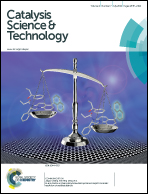The catalytic efficiency of Fe-porphyrins supported on multi-walled carbon nanotubes in the heterogeneous oxidation of hydrocarbons and sulfides in water†
Abstract
Novel recoverable biomimetic catalysts were prepared by the coordinative anchoring of an iron(III) meso-tetraphenyl porphyrin complex [Fe(TPP)Cl] and some derivatives on the activated multi-walled carbon nanotube (AMWCNT) via hydroxyl functionality (Fe-Por–AMWCNT). The simple heterogeneous catalyst [Fe(TPP)Cl–MWCNT] was characterized by powder X-ray diffraction (XRD), transmission electron microscopy (TEM), scanning electron microscopy (SEM), Raman, FT-IR and UV–vis spectroscopy. The amount of catalyst loading on the nanotubes, was determined by inductively coupled plasma atomic emission spectroscopy (ICP-AES). The thermogravimetric analysis (TGA) demonstrated that the nanocatalyst was thermally stable up to almost 400 °C, exhibiting high thermostability. The epoxidation of olefins and the oxidation of saturated hydrocarbons to the related ketones and also sulfides to the sulfones by aqueous solution of tetra-n-butylammonium peroxomonosulfate (n-Bu4NHSO5, TBAOX) were efficiently enhanced with excellent selectivity under the influence of the separable nanocatalyst with very low catalyst loading. Sulfoxides could also be selectively produced in ethanol, which makes the title methodology a good alternative for both sulfoxide and sulfone production. The separation and recycling of the catalyst and oxidant by-products were simple, effective and economical in this clean oxidation method. The FT-IR, UV–vis and leaching experiments after ten successive cycles showed that the catalyst was most strongly anchored to the MWCNT support.


 Please wait while we load your content...
Please wait while we load your content...